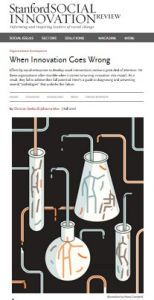Join getAbstract to access the summary!

Join getAbstract to access the summary!
Christian Seelos and Johanna Mair
When Innovation Goes Wrong
Stanford Social Innovation Review, 2016
What's inside?
Don’t fall into an innovation trap.
Recommendation
Organizations that want to have impact in the social sector often focus too narrowly on innovation. Yet even the smartest idea won’t succeed if a social enterprise fails to implement solutions appropriately. Christian Seelos and Johanna Mair, two visiting scholars at the Stanford Center on Philanthropy and Civil Society, identify some of the innovation traps social enterprises fall into, as well as the practices and processes that help make an innovation more effective. Although their study focuses on social enterprises, getAbstract believes that leaders in any type of business can benefit from Seelos and Mair’s advice on how to turn an innovation into success.
Summary
About the Authors
Christian Seelos and Johanna Mair are visiting scholars at the Stanford Center on Philanthropy and Civil Society.

















Comment on this summary